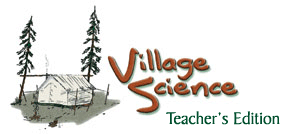|
Teacher
Edition Contents
Skill,
Tools, & Craftsmanship
Cutting
& Drying Fish
Sharpening
Nails,
Pegs, & Lashings
Falling
Trees &
Small-Scale
Logging
Guns
Chainsaw
Clutch & Chain
Ice
Pick
Shelters
Wood
Stoves
Wall
Tents
Steambaths
Insulation
& Vapor Barriers
Gas
Lamps & Gas Stoves
Travel
Piloting
A Boat
Boat
Design
Magnetos
& Spark Plugs
Carburetors
Compression
Outboard
Motor Lower Unit
Outboard
Motor Cooling System
Dogsleds
Snowmachine
Tracks
Snowmachine
Clutch
Snowshoes
Winter
Trails
|
Activities
- Pour rubbing alcohol into your hand. Blow on it. Does it feel
cold? Why? Try the same thing with a small amount of gasoline.
Try now with water. Which cools your hand the most? What causes
the cooling?
It should feel cold from evaporation. Be careful with the
gasoline, but it should feel cold too as it evaporates. Water
will evaporate, but not as fast.
- Did/do people in your village whip themselves with brush in
the steambath? If so, identify the type of brush used in your
area.
- Bring a thermometer into the steambath. What is the temperature
on the floor? At shoulder height? At ceiling height?
- Pour water onto the rocks. Does the temperature actually rise,
or does it just feel hotter?
The temperature rises, but most of the heat is released when
the steam is condensed back to water, releasing it’s latent
heat.
- Ask the people in your village about the best rocks for a steambath.
Where do they get them? Ask them which rocks are not good, and
why. Ask someone who knows about welding and cutting with an acetylene
torch what they can tell you about cutting on concrete. Do you
see any similarities?
Concrete will explode if you heat it with a cutting torch.
The water of hydration in the concrete is released, and turns
to steam, causing the concrete to shoot in many directions.
- Try to clean grease from your hand with water. Try to remove
it with soap. Soak the soap in water. Does it dissolve? Put the
soap in a little stove oil, or vegetable oil. Does it dissolve?
What can you say about soap dissolving in both oil and water?
Soap is slightly soluble in both water and oil.
- Ask the oldtimers how they used to make steambaths when they
were away from the village. They made a little hut from canvas
or skins.
They made a campfire and heated the rocks in the campfire,
then shoveled the rocks into the steambath, removing them when
they got cold, replacing them with hot rocks.
- Ask the oldtimers if there were other reasons for taking steambaths
besides cleanliness.
Steambaths were spiritual and social gatherings.
- Look up “igneous” and “sedimentary”. What
is the difference in their formation?
Igneous comes from fire, or volcanoes. Igneous rocks are generally
ok for steambaths. Sedimentary rocks are formed when silt and
gravel are deposited and pressed together. Sedimentary rocks often
have a high water content, thus making them dangerous for steambaths.
Student Response
- How does perspiring help to cool us off in a steambath?
Evaporation takes heat. When we perspire, the heat comes from
our bodies
- Why do people whip themselves with brush?
To increase circulation in the skin
- Why are rocks important in a steambath?
They have enough mass to hold the temperature steady
- Why are white rocks desirable rather than black ones?
White rocks have less moisture. They don’t explode like
black ones
- Why is the bath hotter at the ceiling than on the floor?
Warm air rises
- Why does soap work well to remove grease and oily dirt?
It is partially soluble in both polar and nonpolar liquids
- What are polar and nonpolar substances?
Polar substances have molecules that are out of balance electronically,
like little magnets. Nonpolar substances are balanced
Math
- My friend Joe takes a steambath every night of the week. From
the time he makes the bath to the time he gets done it takes him
about
- 1/2 hours. What fraction of his life is spent at the steambath.
10.4%
|
